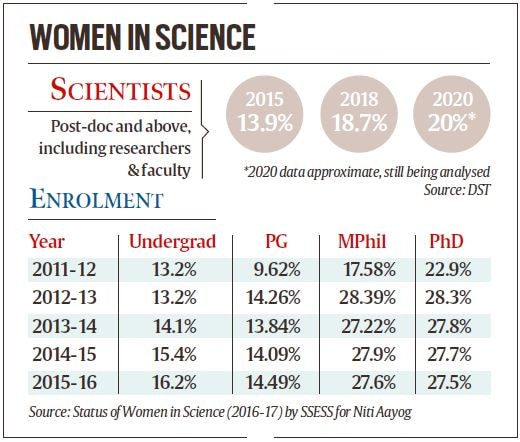Number of women scientists up; CSIR head aims at further push

More than a quarter — 28% — of participants in extramural R&D projects in 2018-19 were women, up from 13% in 2000-01 due to various initiatives taken by successive governments, data compiled by the Department of Science and Technology show. The number of women principal investigators in R&D had risen more than four times from 232 in 2000-01 to 941 in 2016-17.
The percentage of women among researchers went from 13.9% in 2015 to 18.7% in 2018, the data show. There were fewer women researchers in engineering and technology (14.5%) compared with the natural sciences and agriculture (22.5% each), and health sciences (24.5%). The percentage of women researchers in the social sciences and humanities is, however, much higher at 36.4%.
“The increase in women’s participation, especially in research, is due to a combination of government programmes and natural progression. Personally, I have never faced hiccups in my career. But I have seen that women tend to drop out when they get married or have children,” Dr Kalaiselvi told The Indian Express.
However, “this was more in previous decades, as the infrastructure to do both (pursue research and family obligations simultaneously) simply did not exist”, she added. “This is no longer the case. In numerous CSIR labs, women’s participation has increased because there are creche facilities now in the residential colonies where the women scientists live. Parental attitudes towards girls pursuing science has also seen a shift, and girls are now encouraged more.”
A skew; some way to go still
While the overall data show an upward trend, women researchers in engineering and technology are fewer than in natural sciences, health and agriculture. At the post-doctoral level, there are fewer women researchers than the global average..
Dr Kalaiselvi said that as the head of CSIR’s network of 38 laboratories and 4,500 scientists, her aim would be to push for a further increase in the participation of women within the organisation.

Dr S Chandrasekhar, secretary of the Department of Science and Technology (DST), said: “With the increasing use of AI in the sciences, we anticipate that in the next 5-6 years, there will be an exponential growth in women’s participation in S&T — with women using more sophisticated tools that allow remote working, such as something simple like access to online libraries. Even chemical sciences and the industry is getting smarter and cleaner, and I think the number of women employed will now increase.’’
Results of the All India Survey on Higher Education (AISHE) 2019 showed a 53% and 55% participation of women in science education at the Bachelor’s and Master’s levels respectively, numbers that are comparable with many developed countries. But at doctoral level, women graduates (44%) lagged behind men (56%).
“We have observed that participation (of women) is healthy till the postgraduate level. But there is a drop at the post-doctoral level, where most of the research takes place. Even though this too has increased, it is still far less than the 30% global average,” Dr Akhilesh Gupta, senior adviser at the DST, and head of the team that drafted the Science, Technology and Innovation (STI) Policy, said.
The ministry aims to raise women’s participation in S&T to 30% by 2030, Dr Gupta said. “We are already making a push for it…out of the 97 scientists in DST, 35 are women. In the past two years, the majority of the programme committees in the DST have had at least 20-25% women. But the big achievement is that 11 out of 18 divisions in the DST are now headed by women — that is 61%, probably the largest percentage of women in leadership in any government department,’’ Dr Gupta said.
He said that the number of science researchers in India has doubled from 30,000 in 2014 to over 60,000 now. Last year, the DST-supported Gender Advancement for Transforming Institutions (GATI) project, based on the UK’s Athena Swan Charter, was introduced. In the first phase of GATI, 30 educational and research institutes have been selected by DST, with a focus on women’s participation in leadership roles, faculty, and the numbers of women students and researchers.
Newsletter | Click to get the day’s best explainers in your inbox
“In the first phase, which is now complete, we have selected a mix of institutes under S&T including institutes of national importance like IISc, the five IITs, BITS Pilani, research institutes like ICAR, and universities like Delhi University,’’ Dr Nisha Mendiratta, who heads the GATI project, said. DST will study the participation of women in these institutes over the next few months, she said.
According to preliminary findings, the rate of women’s participation is particularly low across the five IITs in
Delhi, Mumbai, Kanpur, Chennai, and Roorkee — ranging from 9% to 14%.
Women’s participation is the highest in biotechnology (40%) and medicine (35%). Dr Mendiratta said ICAR has 29%
women’s participation, CDRI has 18%, NIPER Hyderabad 21%, and the Defence Bio-Engineering and Electro-Medical Lab (DEBEL) in Bangalore has 33%. Delhi University has 33% women’s participation, while Tezpur University in Assam has 17%.

